North Korea fired two missiles into the East Sea on Monday morning, while top officials over the weekend had issued orders to prepare for war. The question is, as always, how serious communist country is this time around?
The two missiles appeared to be Scud-C rockets judging by their range. Early reports say Monday’s North Korean missiles went 305 miles. North Korea’s Scud-C rockets, known as “Hwasong,” only have a range of a few hundred miles. If so, they would not have the range to hit the United States.
But there’s debate as to whether the missiles are Scud-C models. Shin In Kyoon, the head of the Korea Defense Network, said if they’re proven to be “Rodong” missiles—which have much longer range of possibly 620 to 930 miles—it could be problematic and would represent an escalation from the norm. North Korea launched a Rodong-1 missile last year, though it only traveled 400 miles.
Shin said, “If they’re proven to be Rodong rather than Scud missiles, it will indicate that the North is not simply showing off its military force; it’s a provocation of sorts that scoffs at the [South Korea]-U.S. joint drills aimed at removing the North’s nuclear threats,” reported the DailyNK, a South Korea-based news site that focuses on North Korea.
The twin missile launch isn’t unusual for North Korea—particularly in response to the United States and South Korea holding their joint annual spring military exercises.
The General Staff Department of North Korea’s Chosun People’s Army issued a statement, according to DailyNK, which reads that North Korea will “not stand by and let these exercises take place.”
As the Center for Strategic & International Studies (CSIS) noted in its analysis of the Monday’s launch, North Korea often mixes provocation and diplomacy: “North Korea offered to implement a nuclear freeze in return for suspension of exercises last month, which the State Department rejected on the grounds that U.S.-ROK military exercises were lawful while the North’s nuclear program was not.”
It’s the third missile tests carried out by the reclusive, impoverished country in 2015. About a month ago, Pyongyang test-fired a new anti-ship missile. It also fired about five short-range missiles about 150 miles into the East Sea from the port city of Wonsan.
It’s unclear if North Korea will seek to escalate diplomatic tensions, says CSIS. It notes that under Kim Jong Un, who has only been North Korea’s leader for two years, anything could happen.
It says, “2015 has seen President Obama’s imposition of sanctions after the Sony hack, but also the upping of inter-Korean humanitarian assistance and efforts at U.S.-DPRK diplomacy, so the impact on exercises is unclear.”
Kim also apparently made threatening statements a day before the missile launch, according to AFP. He said the Korean People’s Army and elite Guard Units need to be “fully prepared for war politically and ideologically, in military technique and materially.”
The U.S.-South Korea joint exercise, called Key Resolve, includes more than 100,000 South Korean soldiers and about 8,600 U.S. soldiers. Another exercise, known as Foal Eagle, has 200,000 South Korean soldiers and 3,700 U.S. troops.






Friends Read Free